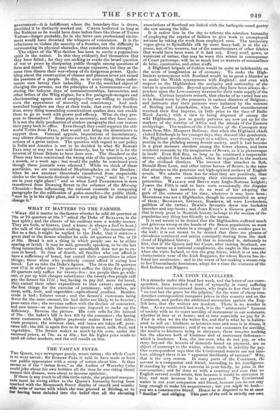THE TARTAN FEVER.
THE Queen, says newspaper gossip, wears tartan ; the whole Court ta to wear tartan ; Sir ROBERT PEEL is said to have made at least oqe public appearance with a scrap of tartan about him. It thus seems as if the "tartan fever," as the Author of W averley (who could joke about his own hobbies all the time he was riding them) named this disease, were about to become epidemic. If there is any truth in all this flute-tattle, the projected masque- rade must be owing either to the Queen's humanity having been touched with the Monmouth Street display of unsold and unsale7 able webs of tartan with which she was greeted at Stirling, or to her having been deluded into the belief that all the elevating
associations of Scotland are linked with the harlequin-cased gentry she saw among the hills. It is rather late in the day to tolerate the mistaken humanity of employing the caprice of fashion to give work to unemployed artisans by taking the work from employed ones. The temporary vogue given to Spitalfields silk by some fancy-ball, is at the ex- pense, not of its wearers, but of the manufacturers of other fabrics that would have been worn if it had not. Every scarf, gown, or waistcoat of tartan, that may be worn this winter in consequence of Court patronage, will be so much lost to weavers of mousseline de laine, cassimeres, and other stuffs.
A Highland brigade of fashion would be quite as indefensible on the score of imagination as of economy. To make the High- landers synonymous with Scotland would be as great a blunder as to make the Welsh synonymous with England; and even with respect to the Highlanders the antiquity and nationality of the tartan is questionable. Beyond question, they have been always de- pendent upon the Low-country weavers for their main supply of the article. Curious inquirers remark, that checks of as varied hue are to be found worn by the peasantry in various districts of Belgium; and insinuate that their patterns were imitated by the weavers of Stirling and Lanarkshire, when the Lowland manufacturers' received their first impetus, (a little prior to the time of Bailie Nicol Jarvie,) with a view to being disposed of among the
wild Highlanders, just as gaudy patterns are now got up for the markets of the interior of Africa and the islands of the Eastern archipelago. The readers of the Chronicles of the Canongate may learn from Mrs. Margaret Bethune, that when the Highland chiefs.
visited Edinburgh in her younger days, they dressed like gentlemen. No Highland gentleman, except as a soldier, ever thought of ap- pearing in the philabeg among decent society, until it had become in a great measure obsolete among the lower classes, and been rendered romantic by the imagination of Scorr, as it is picturesque in itself. Even Rob Roy, so long RS he continued a respectable drover, adopted the broad-cloth, when he repaired to the markets of the civilized districts. The interest that attaches to Rob, Donald Bean Lean, and other tartan heroes of Scorr, is the same that attaches to the generous and high-spirited outlaws of English novels. We admire them less for what they are positively, than for what they are considering their circumstances and op-
portunities. WALLACE and BRUCE were Anglo-Norman knights; JAMES the Fifth is said to have worn occasionally the disguise
of a beggar, but nowhere do we read of his adopting the garb of the caterans of his time, whatever it may have been; MONTROSE was not a Highlander, though he commanded an army
of them ; BUCHANAN, LINDSAY, Balsam:a, all were Lowlanders, guiltless of the tartan; BunNs's favourite dress was buckskin breeches and top-boots ; and Jortx KNox's a Geneva gown. All that is truly great in Scottish history belongs to the section of the population any thing but friendly to the tartan.
It is not meant to be denied that the Highlanders suffered much and grievous wrong at the hands of the Saxon population, as must always be the case where in a struggle of races the weaker goes to
the wall : it is not meant to be denied that there are gleams of chivalrous sentiment and action constantly darting from the dark
cloud of Highland history. All that is intended is, delicately to
hint, that if the Queen and her Court, after visiting Scotland, are to wear tartan as a national compliment, she ought in like manner, when she visits Ireland, to don the gray frieze, which is or was the characteristic wear of the Irish Rapparee, for whom BANIM has in- listed her sentiments ; and in the event of her making a steam-trip to her Transatlantic dominions, adopt for a time the costume of the Red Indians and Niggers.


























 Previous page
Previous page